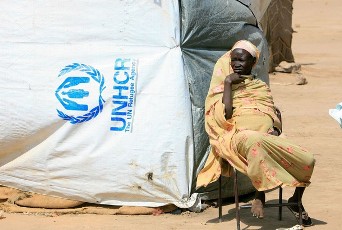UNHCR alarmed by S. Sudan’s current food crisis
March 21, 2014 (JUBA) – The United Nations refugee agency (UNHCR) said Friday that it was gravely concerned about new tensions arising in an area of South Sudan’s Upper Nile state due to food shortages.

“UNHCR is working with authorities and other humanitarian agencies to diffuse the tensions,” she added.
Lejeune-Kaba said competition for natural resources – including firewood, grass and grazing land – has recently boiled over into “tit-for-tat” attacks, forcing up to 8,000 refugees to flee Yusuf Batil camp.
“Houses, tents and granaries belonging to refugees and villagers alike were set on fire during the fighting. Although refugees have since returned to the camp, tensions persist. Maban residents living near Yusuf Batil camp have fled, citing fear of further confrontation with refugees who outnumber them,” she remarked.
Since armed conflict between government and rebel forces broke out in South Sudan in mid-December, instability and conflict in the region have disrupted planting and harvesting. At the same time, insecurity along transportation routes has hampered the delivery of food and other humanitarian supplies.
During the first week of March, refugees across Maban’s four camps reportedly received a 10-day ration of pulses and oil. Pulses and oil cover only 24 per cent of the daily energy needs of 2,100 kcal.
“Shortages have left refugees without cereals and salt for several weeks. Some key non-food items, including fuel and medicine, are running out”, the official said.
“There is a need to ensure adequate supplies are in place before the onset of the rains or else all deliveries will have to be undertaken by air,” she added.
“Without enough to eat, refugees have been growing restless. Some have threatened to return to Sudan’s Blue Nile state, which they fled because of continuing armed conflict,” she noted.
Maban county, according to UNHCR, hosts 125,000 Sudanese refugees from Blue Nile. A third of the refugee population is reportedly made up of small children, pregnant and lactating women, elderly and disabled people and the chronically-ill.
The governments of South Sudan and of Ethiopia have reportedly agreed to allow humanitarian supplies through Gambella, Ethiopia, which will enable the World Food Programme (WFP) to dispatch much needed food commodities for internally displaced people and refugees in Maban in the coming days.
Meanwhile, the insecurity and hunger have reportedly forced more South Sudanese to flee into neighbouring countries such as Ethiopia, where an average of 1,000 South Sudanese refugees arrive daily. The refugees, mainly women and children, have been arriving in the Gambella region from Upper Nile and Jonglei states.
The government had made land available for two new camps in Gambella – Leitchuor camp opened in mid-January and Kule in late February. But Leitchuor, with 30,000 people, has exceeded its capacity, and Kule is fast approaching its limit of 20,000.
The refugees still face challenges, including serious health concerns. Many arrive malnourished. “With WFP and UNICEF, we have established feeding programs to support their recovery,” said the UNHCR spokesperson.
POLIO AND MEASLES VACCINATIONS
Meanwhile, UNHCR said new arrivals were vaccinated against polio and measles at the Pagak entry point or in the camps. UNHCR is putting into place child protection programmes, such as family tracing for separated or unaccompanied minors.
Sudan, according to the agency, also continues to receive South Sudanese, at the rate of approximately 350 per day.
“The condition of those arriving is dire, as they are coming with almost no belongings. An inter-agency assessment has been requested by the government to assess and respond to all needs of the new arrivals; humanitarian teams will travel imminently to the locations,” said the refugee agency’s spokesperson.
There are now more than 44,000 South Sudanese in Sudan. While most have received food, many cannot cook due to limited access to firewood and lack of cooking utensils. Most families rely on the distribution of emergency rations.
Uganda hosts the largest population of South Sudanese refugees, with more than 82,000 arrivals since mid-December.
“While the daily arrival rate has gone down, we are seeing a growing number of men arriving with their families – a shift from earlier, when men would only escort their wives and children to the border,” said Lejeune-Kaba.
Nearly 26,000 South Sudanese have crossed into Kenya. Despite their relatively low numbers, their presence has pushed the Kakuma camp beyond its 150,000 capacity.
“We are therefore negotiating additional sites, but in the interim we have resorted to using some green spaces to accommodate new refugees,” said Lejeune-Kaba.
As in the other neighbouring countries, many of the South Sudanese are reportedly arriving in Kenya malnourished. In Kakuma, UNHCR reportedly plans to extend a blanket feeding programme to children up to 59 months old, as opposed to the current 23 months.
(ST).
